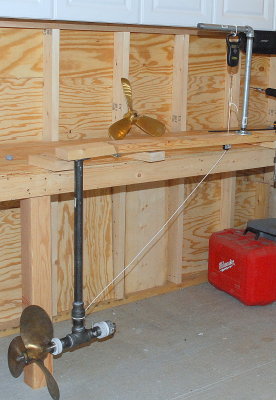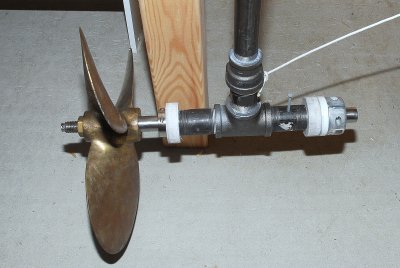It's not just MIT. The University of Strathclyde's Ocean Engineering Department also looked at this. Then, last year, Yachting Monthly, a European publication, actually pulled real sailboats through the water, at sailboat speeds, and came to the same conclusion.
You are right that this is not a simple question, it is not. I think though that it got more interesting when YM actually towed a real sailboat through the water, at sailboat speeds, with a strain gauge in fixed and free wheeling, and the conclusion was still that the locked prop caused more drag.
Interestingly enough I also did some of my own testing with a very typical 16"X12P three blade Michigan Wheel and the results were not even close. The locked prop caused significantly more drag when towed through the water. I even closely matched the bearing resistance to that of my own vessel.
In the video I could only get to about 4.2 knots towing the jig but I later replicated this with a larger motor and got to 6.5-6.9 knots and the results were similar except that the locked prop maxed out my scale so I could not discern max load of the locked prop with only a 50 pound scale.
Your tests at those speeds with a 12"P prop give predicable results.
A 12P prop at 4.2 knots is spinning at 420RPM if the slip ratio is zero. At 6.5 knots it is spinning at 650RPM at zero slip. (using 6000 ft / nm because I'm lazy)
The average speed of the water across a spinning prop is not the same as the towing speed. The speed of the water that the tip of the "sees" is equal to circumference X RPM. The average speed the blade "sees" is at one half the diameter.
For your 16x12P prop the average water velocity at your test speeds and zero slip RPM is 209% of the towing speed. A 16x6P prop would see 418% of the towing speed at the blade.
For towing speed 4.2 the average blade speeds are:
14.7 FPS for Pitch = 12
29.3 FPS for Pitch = 6
Drag = Cd x area x 1/2 x kinematic viscosity x velocity^2
The same blade at P=12 and P=6 will have the same area, the same CD, and the viscosity of the water is the same the constants become one factor the only variable is velocity ... so for this test:
Drag = Constant x V^2
Assume Constant = 1
The 6P prop will have Drag = 4 times the 12P drag just due to the higher RPM is must spin at zero slip.
If two props of the same blade area can have a difference of 400% in drag just due to pitch change, just how valid are the tests you ran?
It would be more valid to test two props with the same diameter and blade area with two different pitches. The drag curves will not be the same. The lower pitch prop will always have greater drag since it must spin faster at the same towing speed.
I'm not trying to argue or prove you or anyone else wrong, I am just pointing out that the biggest variable in towing drag tests is the pitch of the prop.
If you can get a feathering prop and lock the pitch at different angles you will get different drag numbers for the same towing speeds. A feathered blade will see water speed = tow speed. The drag will be X. Ad some pitch to the blade so it spins and the water speed over the blade will be higher than when not spinning and the drag will be increased by the square of that increase. At 0 pitch the prop will not spin and the full blade area will be the only source of drag.
Prop RPM will be zero when feathered (infinite pitch) and zero when set to 0 pitch. The drag will be directly proportional to the area at 90 degrees to the flow.
A freewheeling prop will reduce the effective area 90 degrees to the flow. To do this it must generate lift from the blades to overcome the increased drag due to the increased velocity from non-zero RPM. The same prop will have minimum drag when not spinning and feathered, more drag if pitch forces it to spin to align the blades with local flow and even more drag when locked with the blades at zero pitch.
I really admire your method. You have repeatable results and a scientific approach to the problem, however, like the other tests, your set of variables produce results that are only valid for the test conditions. You did not tow fast enough to get a 12P prop to reach it's limiting RPM.
One of the things to look at is the effective drag area of the props tested. For a 12P prop of the classic Michigan Wheel type the blades are twisted, they have a shallow angle at the tip and a steep angle near the hub. Ideally for one revolution each part of the blade will advance 12 inches. Since the tip travels twice as far through the water as the middle of the blade the tip angle will be about half of the average angle. Figure out what the area of the blade is at this angle and compare it to the area at 90 degrees to the shaft. It will be much smaller. Perhaps only 15% of the area when at the design point of 12P compared to its area at 90 deg.
Drag = Cd x Area x 1/2 x kV x V^2
We are only changing Area this time so 1/2 kV, V^2, and CD become our constant and drag is a linear function of Area.
I would expect a spinning prop to have only 15% of the drag of the locked prop based on area alone.
It is not as simple as this. The Cd also changes. For the blade at the design angle Cd might be .5 and for a flat plate (locked) it might be 1.17 or so.
Now we have:
Drag Locked = 1.17 x Locked Area x kV x V^2
Drag Spinning = .1 x Spinning Area x kV x V^2
A 16" diameter disk has area = 201.66 in^2 ... the blade area might be 25% of this for a three bladed prop? So 50 in^2? or .35 ft^2
Assume Locked Area to be .35 ft^2 the spinning area to be .05 ft^2 and the kV of water to be 1. (So the formula produces drag in pounds)
At 4.2 knots (7FPS)
Dlocked = 1.17 x .35 x .5 x 7^2 = 10 pounds Drag
Dspin12P = .5 x .05 x .5 x 14.7^2 = 3 pounds Drag
Dspin6P = .5 x .05 x .5 x 29.3^2 = 11 pounds Drag
Simple math suggests that you should have seen a 70% increase in drag for the prop when locked. It also suggests that had you tested a 6P prop you would have seen a drag increase when the prop was freewheeling.
It gets even more complicated than this. The drag estimates above do not consider shaft friction. The spinning drag estimates are the drag that must be overcome to spin the prop. That force has to come from lift generated by the blade. For constant RPM the lift will equal the blade drag. So the Cl of the blade will equal the Cd ... this gets us into 3D foil theory and induced drag. The result will be that the spinning prop will have higher drag than this estimate and the low pitched prop will have higher drag than when fixed at a lower boat speed.
High pitch props at the speeds tested lead to one conclusion, low pitched props tested under the same conditions will lead to the opposite conclusion.
As you said, your results are valid for those two props at those speeds. That does not mean that all props are lower drag when freewheeling at all speeds.
The relationships become very complex and all the testing done has not lead to valid conclusions for all cases.
This is something that I tested years ago with props on model aircraft. The same debate rages ... "How is glide effected by a locked, feathered, freewheeling, or folding prop?"
As you might guess the drag low to high is:
Folding
Feathering
and "It depends on pitch and glide speed" for Freewheeling vs Locked.
The same is true for sailboat props.







